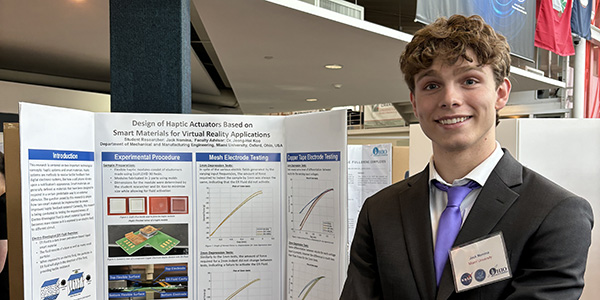Miami student wins award for virtual reality haptics research
Jack Nomina’s haptic technology research could expand VR applications for professional training

Miami student wins award for virtual reality haptics research
A Miami University student won an award for his research on haptic technology that could expand the applications of virtual reality to train individuals in healthcare, astronautics and aviation, and other professions.
Senior Jack Nomina, a Mechanical Engineering and Music Performance double major, earned a perfect score from evaluators at the Ohio Space Grant Consortium’s (OSGC) Annual Student Research Symposium in April for his poster presentation on “The Design of Haptic Actuators Using Smart Materials for Virtual Reality Applications.” He was the only presenter from Miami at the symposium.
“I got a lot of really great experience explaining my research to people with varying levels of background experience,” Nomina said about the consortium. “Learning how to explain things to those different levels of audiences was really valuable for me as well as just the experience of communicating my research through a physical medium.”
The OSGC is a statewide network of colleges and universities working to expand opportunities for Ohioans to understand and participate in NASA’s aeronautics and space projects. While surprised by the award, Nomina said he felt honored that the evaluators recognized his research. Through the OSGC, he connected with AGarvey, LLC, an engineering firm located near Dayton where he interned for the summer.
During Nomina’s sophomore year, he developed a relationship with his faculty mentor Jeong-Hoi Koo, professor of Mechanical and Manufacturing Engineering, while taking one of his courses. Koo encouraged Nomina to join his lab, which started his research journey, though Nomina admitted he initially wasn’t sure he’d have the time to take part in research at all.
“I have always been interested in research, but I thought it was something I would never have the opportunity to get into. I honestly didn’t think I had time,” Nomina said. As a Mechanical Engineering and Music Performance double major, and the vice president of multiple clubs, he was juggling a full schedule. But he made it work.

When people think of virtual reality, they might think of “Ready Player One,” a science fiction story where people use visors and haptic technology to access a virtual world called the OASIS. While not far off the mark for what virtual reality can be used for, Nomina’s research extends far beyond just entertainment and video games.
“A haptic actuator is something that allows you to interact with a virtual environment,” Nomina explained. “Smart materials are any material that has a special response to external stimuli.”
Nomina added that haptics are everywhere and people are likely more familiar with them than they realize. When a phone vibrates from a notification or when a video game controller rumbles from a game cue, that’s haptics at work. Smart materials generate the haptic feedback that allows people to interact with the digital environment.
Nomina’s research focuses on testing smart materials to help create advanced haptics that can simulate more complex feelings, like imitating different textures or surfaces. By stimulating electrorheological (ER) fluid within these smart materials with varying input voltages, he can study how to create different haptic sensations. The hope is that in the future, these smart materials can then be integrated into a computer program so people can interact with a virtual environment, which has many potential applications.
One of these applications could help train professionals in different fields. Medical mannequins, which simulate a human patient and train medical professionals on complex procedures, often cost thousands of dollars due to their materials, functionality, and technological features. Creating a virtual reality system using haptic feedback, Nomina said, could help hospitals save money and make training for medical professionals easier and more accessible, giving them more opportunities to practice procedures. Haptics could also help train astronauts, simulating the sensations they would experience while in low orbit or even on another planet.
The opportunity to pursue undergraduate research with Koo has benefited Nomina significantly; he’s gotten hands-on experience with 3D-printing, manufacturing methods, and testing methods of advanced materials. Presenting his research to professionals has helped him not only build his confidence, but also network and collaborate with students and professionals in the same field. Now Nomina plans to pursue a career in research, including working towards a Ph.D.
“If you have any interest at all, I think Miami is one of the best places to get into research in your undergrad. Miami’s structure is really conducive to finding a lot of success in undergraduate research,” Nomina said. “Just try to build a relationship with a professor. Reach out to them, see if they have any openings in their lab and if they’re interested in taking more students.”